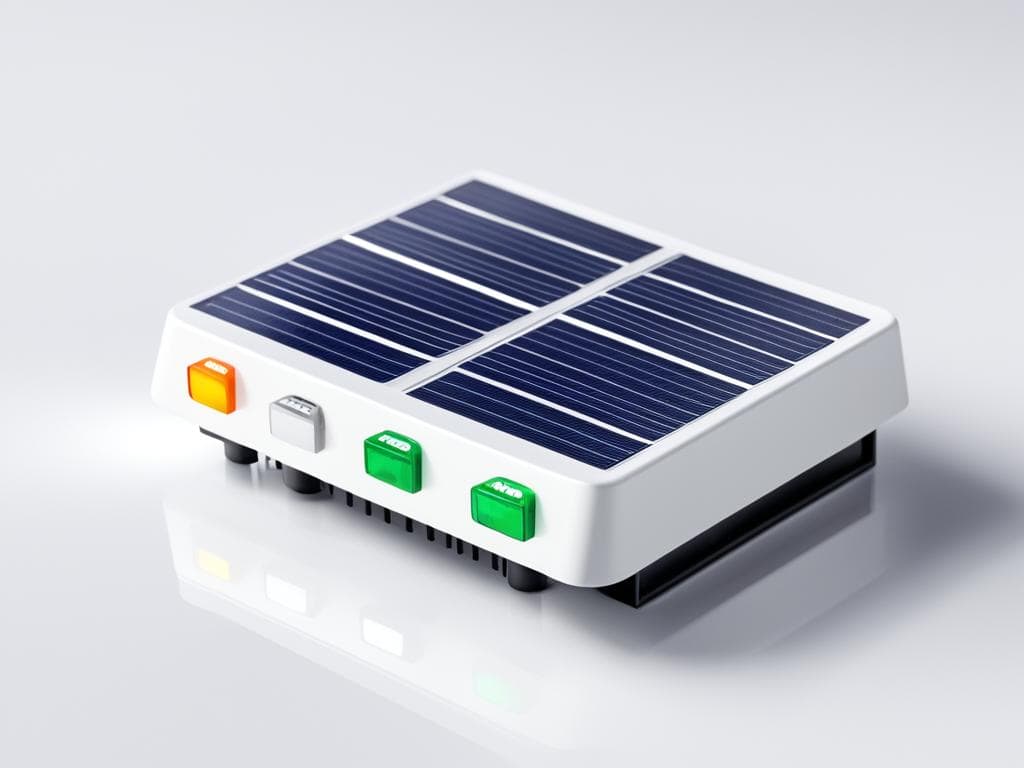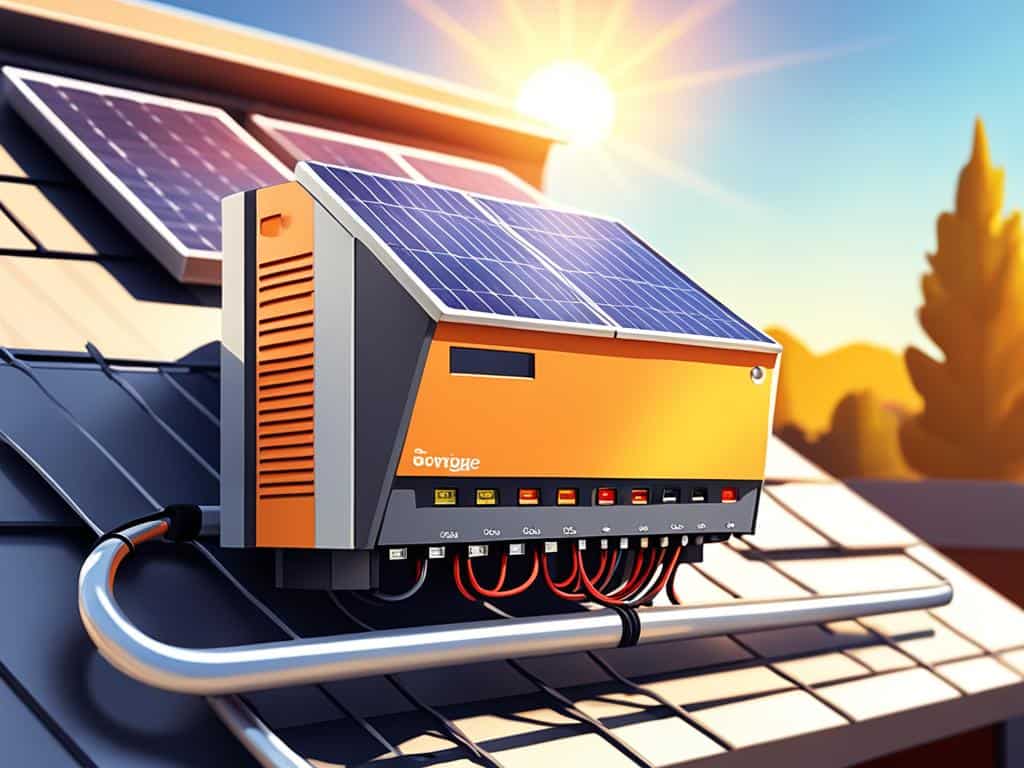Solar Charge Controller Essentials Guide
Discover the key features and benefits of the best solar charge controllers to enhance your home’s energy efficiency with our expert guide.

Have you ever thought about the best way to use solar power without harming your batteries? A solar charge controller is the answer. Fenice Energy shows you how to pick the best solar charge controller for your needs. Whether you need a solar charge controller for a small setup or a large home system, we explain its importance.
In India, sunshine is plenty and the search for clean energy grows. Choosing the right solar charge controller for home is more than a choice. It’s a step towards a greener future. We’ll look at Affordable solar charge controllers to high-end ones that boost your power. Let’s explore solar charge controller features that make your home’s energy system better and more reliable.
Stay tuned for our solar charge controller reviews. Learn how these crucial devices impact your solar projects. With Fenice Energy’s vast experience in clean energy solutions, including controllers, you’ll find the right energy manager.
Key Takeaways
-
- Discerning the operational benefits of PWM and MPPT solar charge controllers to enhance home energy systems.
- Observing how to select the best solar charge controller that matches your system’s requirements and budget.
- Identifying solar charge controller features that protect batteries and improve system longevity.
- Understanding the essential role of a solar panel charge controller in preventing damage and maximizing efficiency.
- Appreciating the long-term cost savings with affordable solar charge controller choices without compromising on performance.
Understanding the Role of a Solar Charge Controller
A solar charge controller plays a key role in any eco-friendly energy system. It ensures solar system efficiency and home energy efficiency. It does more than just gather sun power; it carefully manages and guards that power for future use. In places like India, where Fenice Energy leads in clean energy, knowing how charge controllers work helps keep your solar investment safe and effective.
Why a Charge Controller is Vital for Solar Systems
The benefits of solar charge controller benefits are many. They help get the most power from the sun and stop energy waste. They adjust to the changing voltages from solar panels, which is important. Solar panels work differently in various temperatures. So, a smart charge controller is crucial for getting top performance from your solar setup no matter the weather.
How a Solar Charge Controller Protects Your Batteries
At their core, charge controllers protect your batteries. They prevent harmful overcharging, which can lower a battery’s life and efficiency. This is vital as batteries come in many types now. Each type needs careful charge management to work well for a long time. Fenice Energy focuses on using these controllers to help keep energy systems running smoothly.
It’s also key to know about different charging methods. For instance, MediaTek’s Pump Express supports certain voltage levels. Qualcomm’s Quick Charge, however, is more flexible. It allows small changes to voltage to match the best charging level for the battery. MPPT solar charge controllers offer even more. They match PV module output to battery needs, making the whole system more efficient.
| Feature | Quick Charge | Pump Express | MPPT Charge Controllers |
|---|---|---|---|
| Battery Protection | Optimized voltage levels | Fixed support voltage levels | Dynamic voltage tracking |
| Efficiency | Variable increments for precision | Fixed increments for robustness | Up to 30% increase in solar array effectiveness |
| System Compatibility | Wide range support up to 20 volts | Narrower focus with specific voltages | Adaptable to higher voltage PV modules |
| Operational Assurance | Optimum charging via voltage match | Limited by lack of 7-volt level in earlier versions | Advanced microprocessor control for reliability |
In short, solar charge controllers are key for solar system efficiency and battery protection. They manage energy flow and guard against damage. These controllers are must-haves in solar energy setups, especially in India’s tough environments. Fenice Energy keeps powering homes and businesses with top-notch solar technology.
The Technical Mechanics of Solar Charge Controllers
At the heart of any off-grid solar setup, solar charge controller operation is key. It keeps energy transfer balanced and efficient. Energy flow regulation by these devices stops batteries from overcharging or undercharging. This is crucial for safety and making batteries last longer.
Learning how solar charge controllers work shows why they’re vital in renewable energy. Companies like Fenice Energy focus on giving the best clean energy solutions.
How Solar Charge Controllers Regulate Energy Flow
The process of solar charge controller operation is interesting. It starts with noticing the battery voltage and then changing solar panel inputs. This careful control avoids dangerous overcharging. They use advanced tech to oversee various power sources. This ensures a constant, safe energy supply. Fenice Energy has over 20 years of experience, offering solutions for homes and businesses.
The Impact of Temperature on Charge Controller Performance
The charge controller temperature sensitivity is an important but often overlooked factor. Controllers adjust charging volts depending on the temperature around them. High temperatures can harm batteries quickly, and low temperatures can cause undercharging. Temperature-compensating controllers protect against these issues. They meet Class 1 Division 2 standards for safety. Fenice Energy has robust options for these controllers.
| Type | Price Range in INR | Efficiency | Suitable for System Size | Advanced Features |
|---|---|---|---|---|
| MPPT | ₹5,200 – ₹45,000 | High | Larger Systems (Cabins, Homesteads) | Bluetooth Connectivity, Multi-Voltage Support |
| PWM | ₹1,100 – ₹3,000 | Lower | Small Systems (RVs, Boats) | Basic Display Types, Simple Settings |
The market offers a broad range of choices. Knowing the differences between PWM and MPPT solar charge controllers helps in improving off-grid solar setups. Fenice Energy provides both types. They meet the varied needs of regulating energy flow and protecting systems. This ensures users find the best product for their needs.
Comparing PWM and MPPT Charge Controllers
Choosing the right solar charge controller is key, with MPPT and PWM being the main types. Fenice Energy sheds light on their advantages and best use cases.
PWM controllers are perfect for small solar setups, costing between INR 1,100 to INR 3,000. They’re great for home use, like powering RV electronics. However, they have a lower efficiency, between 70% to 90%.
MPPT controllers, however, are built for larger systems needing better energy management. Prices range from INR 5,300 to INR 45,000. They convert over 90% of solar energy, which explains the higher cost.
Fenice Energy advises using a solar charge controller for any panel above 2 watts. It protects the battery and regulates energy efficiently.
MPPT controllers are superior in cold climates, capturing up to 30% more energy than PWM controllers. They work well when solar panel voltage is higher than the battery’s. MPPT technology can handle wide voltage ranges, ensuring up to 99% efficiency.
- MPPT controllers adapt to various climates and system sizes, optimizing solar energy.
- PWM controllers are budget-friendly for smaller, simpler systems.
- Both types protect batteries and panels, boosting system longevity and stability.
Fenice Energy recommends MPPT for scalable solar projects and changing environments. If your setup is small and panel voltage matches the battery’s, PWM could be enough.
How to Select the Best Solar Charge Controller for Your Needs
Finding the right solar charge controller is key for an effective solar system. There are many options to consider, especially regarding panel and battery compatibility. We’ll help you look at the critical factors for picking the best controller. This will ensure it fits well with your other solar components.
Assessment of Solar Panel and Battery Specifications
First, check the maximum power your solar panels can produce and what your batteries need. The choice between PWM and MPPT controllers depends on these specifics. For example, with 240W from your panel, a PWM might waste about 120W. But an MPPT controller can use all the panel’s power, avoiding waste.
Aligning Controller Specifications with Solar System Size
In smaller places like homes in India, a PWM controller might be enough. They’re cheaper but not great for high power. For bigger buildings or industrial uses, MPPT controllers work better because they’re about 96% efficient. These controllers also let you mix panels and batteries of different voltages effectively.
Lento, a leading brand in India, sells these controllers at good prices, like ₹710 and ₹850. Their MPPT controllers can make charging 30% more efficient. They come with automatic operation and can handle 12V/24V, which is great for complex setups.
When selecting a controller, remember that a 3,000-watt setup with a 48-volt battery needs a controller for at least 62.5 amps. Getting the capacity right prevents problems and allows for features like Equalization and Ground Fault Protection. It’s also good for using various MPPT settings effectively.
For making the best choice for your project, talk to the manufacturers. They can offer advice that fits your system’s specific needs.

Analyzing Solar Charge Controller Features
The global Solar Charge Controller Market is booming. It’s expected to hit INR 2.52 lakh crores (USD 3.23 billion) by 2030. Fenice Energy leads this growth, making products that are smart and reliable.
Understanding LED Indicators and Digital Displays
Fenice Energy’s solar charge controllers make it easy to see how your system is doing. They use LED lights and digital displays. These show important info like power levels and battery status. Advanced controllers even adjust for temperature and ensure even charging to keep batteries healthy.
The Significance of Voltage and Current Regulation
Voltage and current control are crucial for solar charge controllers. Fenice Energy’s controllers prevent batteries from overcharging or undercharging. This improves energy storage. Hybrid controllers are even better. They handle power from various sources.
MPPT solar charge controllers are gaining ground, especially in business settings. They perform best and are very efficient. The Asia Pacific region, including India, is seeing rapid growth. This is due to a push for off-grid power and renewable energy.
Tools like MATLAB/Simulink help in designing these advanced controllers. Techniques and algorithms like SOGI and GDLSR NN improve how well these systems work. This is vital for solar power that’s connected to the grid.
| Feature | Description | Benefit |
|---|---|---|
| LED Indicators | Visual cues for charge status, power levels | Quick and easy system diagnostics |
| Digital Displays | Displays detailed voltage, current, and system information | Precise monitoring and control |
| Voltage Regulation | Maintains optimal battery charge levels; includes temperature compensation | Protects batteries, optimizes performance |
| Current Regulation | Controls the charge current intensity to batteries | Prevents overcharging, extends battery lifespan |
| MPPT Technology | Maximizes power extraction from PV panels | Up to 30% increase in energy production |
| Hybrid Functionality | Works with multiple energy sources | Optimizes energy use and storage |
Fenice Energy is changing the game in solar energy. Their controllers meet the market’s varied demands. They focus on advanced display info and strong voltage and current control. They’re a top choice for both home and business solar setups.
Solar Charge Controller for Home: Incorporating Local Energy Solutions
Switching to clean energy at home in India is now easy with available solar solutions. Homeowners can use solar charge controller products to effectively manage their solar systems. These devices ensure safe battery charging, improve energy use, and help switch to renewable energy smoothly.
It’s important to choose the right solar charge controller. Whether you pick a PWM (Pulse Width Modulation) or an MPPT (Maximum Power Point Tracking) controller depends on your solar setup. PWM controllers work well for smaller systems and cost between INR 1,100 to INR 9,300. MPPT controllers, suited for larger setups, are priced from INR 2,100 to INR 24,100 and offer better efficiency.
Fenice Energy leads in providing effective solar charge controllers in India. These controllers, vital for a home’s green energy system, match different setups, whether grid-connected or off-grid.
Here’s a comparative table to help pick the best solar charge controller for your home:
| Charge Controller Type | Suitability | Recommended Power Threshold | Operating Temperature | Average Price Range in INR |
|---|---|---|---|---|
| PWM Solar Charge Controller | Optimal for off-grid, smaller systems | Less than 150 watts | –25°C to +60°C | 1,100 to 9,300 |
| MPPT Solar Charge Controller | Effective for large, grid-connected or off-grid systems | Greater than 150 watts | –40°C to +60°C | 2,100 to 24,100 |
With more homes going solar, knowing the costs, size, and rules for installation is key. You’ll need a load analysis to pick the right system size. You also need to follow building codes to ensure the system is safe, efficient, and legal. Choosing technology like crystalline silicon solar cells, which are popular, makes your energy source more reliable and sustainable. Opt for efficient systems like those from Fenice Energy to boost power production and meet your needs.
Fenice Energy stays ahead with the latest solar charge controller tech in India. They aim to give homeowners clean energy that’s affordable, reliable, and sustainable.
Installation and Maintenance Tips for Solar Charge Controllers
To harness solar energy well, installing solar charge controllers right is key. Not all solar setups in cities need a solar charge controller. But, every off-grid system does. This highlights its importance for safety and boosting system function. Fenice Energy knows how vital correct installation is to make the most of solar investments.
Optimizing Controller Placement for Performance
The installation spot of your solar charge controller matters a lot for its performance. Choose a cool, dry place away from heat and water. This follows maintenance advice important for lasting results. PWM solar charge controllers are priced from INR 1,200 to INR 3,200. MPPT types cost between INR 5,600 to INR 48,000. Fenice Energy helps pick the right controller for panels over 2 watts. This ensures strong performance and battery life through careful voltage control.
Routine Checks and Safety Measures to Prevent System Failure
Regular checks are crucial to stop overcharging, undercharging, or strange behavior. Checking components, cleaning, and securing connections help avoid downtimes. Using the right cable sizes and adding overcurrent protection keep systems safe and functional. Regular maintenance greatly extends your solar system’s life.
Fenice Energy focuses on clean energy and solar charge controller upkeep. They recommend Morningstar controllers for their advanced features. Following these maintenance tips keeps PWM or MPPT controllers working well in all conditions. This keeps your solar system efficient, reliable, and ready to capture solar energy effectively.
Affordable Solar Charge Controller Options and Considerations
Embracing solar energy is a smart step for a greener life and big savings, especially in sunny places like India. Cost-effective solar charge controllers help people use solar power without spending a lot. Right now, in 2023, you can find affordable solar charge controllers in India priced between ₹710 and ₹850. This makes switching to solar power easier than before.
Solar charge controllers play a key role in keeping solar batteries safe and lasting longer. They stop batteries from getting overcharged or undercharged. Lento is a well-known brand offering durable solar charge controllers at good prices. These come with overcharging protection and reverse polarity protection. They work well with various battery types such as Gel, tubular, and flooded, showing Lento’s dedication to flexible solar system savings.
It’s important to know about different solar charge controllers. PWM controllers are more budget-friendly and great for solar beginners. MPPT controllers cost a bit more but can boost charging by up to 30%, making them a smart pick for bigger solar projects.
Deciding on a solar charge controller means looking at current capacity, longevity, and if it will fit future solar projects. Lento has solar charge controllers ranging from 10A to 20A. They’re easy to install and have features like temperature detection and compensation.
- MPPT controllers can create up to 25% more power than PWM controllers. This is especially good for big solar projects.
- For example, a 180W panel with MPPT technology gets 11.1% more energy than a 160W panel with PWM. This shows MPPT’s efficiency.
- Also, MPPT controllers, like Victron SmartSolar ones, often have modern features like Bluetooth for easy remote checking.
If you’re planning your solar system, think about your panel size and count. Bigger panels over 32 cells need an MPPT controller for the extra power. Lento makes sure their MPPT solar charge controllers work with the latest panel technologies, like SunPower cells.
Experts at Fenice Energy recommend avoiding cheap controllers that pretend to be MPPT but miss vital protections. This can lead to expensive damage. A good design and wiring can let you use multiple chargers, raising the charge capacity and system efficiency.
Having the right knowledge helps you enjoy budget-friendly solar energy without losing quality. Whether for home or larger setups, choosing cost-effective solar charge controllers from trusted brands like Lento keeps both your system and savings in good shape.
Conclusion
Starting your journey with solar energy is smart. Solar charge controllers are key for energy efficiency. There are several types of controllers available. PWM charge controllers are budget-friendly. They work well for small to medium solar setups. They help make a wise choice in solar energy. MPPT controllers are for larger systems. They offer great efficiency. These can work with high voltage solar panels and low voltage batteries.
Fenice Energy leads the way in this energy shift. They ensure batteries last long and systems are reliable. They add features like battery temperature control and overload protection. Real-time monitoring shows how the system is doing. These advancements show how charge controllers are evolving. Plus, IoT for remote control and AI to make things better show this tech is advancing. It’s important to choose a controller that meets your energy needs now and in the future.
Choosing the right solar charge controller affects how long your investment lasts. MPPT and PWM controllers each have their own benefits. They can offer up to 96% efficiency and save money. Solar setups are becoming key in both city and remote areas in India. A good charge controller is crucial for solar solutions. It prevents overcharging. This connects green enthusiasts to a vast potential. Fenice Energy provides strong control options for your needs. They capture what smart, eco-friendly living is all about.


